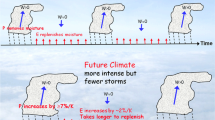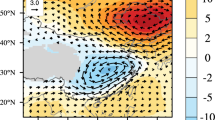Abstract
In this study we present rainfall results from equilibrium 1 ×− and 2 × CO2 experiments with the CSIRO 4-level general circulation model. The 1 × CO2 results are discussed in relation to observed climate. Discussion of the 2 × CO2 results focuses upon changes in convective and non-convective rainfall as simulated in the model, and the consequences these changes have for simulated daily rainfall intensity and the frequency of heavy rainfall events. In doing this analysis, we recognize the significant shortcomings of GCM simulations of precipitation processes. However, because of the potential significance of any changes in heavy rainfall events as a result of the enhanced greenhouse effect, we believe a first examination of relevant GCM rainfall results is warranted. Generally, the model results show a marked increase in rainfall originating from penetrative convection and, in the mid-latitudes, a decline in largescale (non-convective) rainfall. It is argued that these changes in rainfall type are a consequence of the increased moisture holding capacity of the warmer atmosphere simulated for 2 × CO2 conditions. Related to changes in rainfall type, rainfall intensity (rain per rain day) increases in the model for most regions of the globe. Increases extend even to regions where total rainfall decreases. Indeed, the greater intensity of daily rainfall is a much clearer response of the model to increased greenhouse gases than the changes in total rainfall. We also find a decrease in the number of rainy days in the middle latitudes of both the Northern and Southern Hemispheres. To further elucidate these results daily rainfall frequency distributions are examined globally and for four selected regions of interest. In all regions the frequency of high rainfall events increases, and the return period of such events decreases markedly. If realistic, the findings have potentially serious practical implications in terms of an increased frequency and severity of floods in most regions. However, we discuss various important sources of uncertainty in the results presented, and indicate the need for rainfall intensity results to be examined in enhanced greenhouse experiments with other GCMs.
Similar content being viewed by others
References
Chouinard C, Beland M, McFarlane N (1986) A simple gravity wave drag parameterisation for use in medium-range weather forecast models. Atmos Ocean 24:91–110
Gates WL, Han YJ, Schlesinger ME (1985) The global climate simulated by a coupled atmosphere-ocean general circulation model — preliminary results. In: Nihoul JCJ (ed) Coupled ocean-atmosphere models. Elsevier Oceanography Series 40, pp 131–151
Ghan AJ, Lingas JW, Schlesinger ME, Mobley RL, Gates WL (1982) A documentation of the OSU two-level atmospheric general circulation model. Rep No. 35, Climatic Research Institute, Oregon State University, Corvallis, Oregon, USA
Gordon HB (1981) A flux formulation of the spectral atmospheric equations suitable for use in long term climate modelling. Mon Weath Rev 109:56–64
Gordon HB (1992) A documentation of the CSIRO 4-level atmospheric general circulation model. CSIRO Div Atmos Res Tech Pap 28 (in press)
Hansen J, Lacis A, Rind D, Russell G, Stone P, Fung I, Ruedy R, Lerner J (1984) Climate sensitivity: analysis of feedback mechanisms. In: Hansen JE, Takahashi T (eds) Climate processes and climate sensitivity. Amer Geophys Union, Washington DC, 130–163
Hansen J, Rind D, DelGenio A, Lacis A, Lebedeff S, Prather M, Ruedy R (1988) Regional greenhouse climate effects. In: Coping with climate change. Proc 2nd N Am Conf Preparing for Climate Change. Dec. 6–8, 1988, Clim Inst, Washington DC
Hense A, Krahe P, Flohn H (1988) Recent fluctuations of tropical temperature and water vapour content in the tropics. Meteorol Atmos Phys 38:215–227
Houghton JT, Jenkins GJ, Ephraums JJ (1990) Climate change — the IPCC scientific assessment. Cambridge University Press, Cambridge, UK
Hunt BG, Gordon HB (1988) The problem of “naturally”-occur-ring drought. Clim Dyn 3:19–33
Hunt BG, Gordon HB (1991) Simulations of the US drought of 1988. Int J Clin 11:629–644
Jaeger L (1976) Monatskarten des Niederschlags fur die ganze Erde. Ber Deutsch Wetterdienstes 18:139
Manabe S, Stouffer RJ (1988) Two stable equilibria of a coupled ocean-atmosphere model. J Clim 1:841–866
Mearns LO, Katz RW, Schneider SH (1984) Extreme high temperature events: changes in their probabilities with changes in mean temperature. J Clim Appl Meteorol 23:1601–1613
Mearns LO, Schneider SH, Thompson SL, McDaniel LR (1990) Analysis of climate variability in general circulation models: comparison with observations and changes in variability in 2 × CO2 experiments. J Geophys Res 95: 20469–20490
Noda A, Tokioka T (1989) The effect of doubling the CO2 concentration on convective and non-convective precipitation in a general circulation model coupled with a simple mixed layer ocean model. J Meteor Soc Japan 67:1057–1069
Palmer TN, Shutts GJ, Swinbank R (1986) Alleviation of a systematic westerly bias in general circulation and numerical weather prediction models through an orographic gravity wave drag parameterisation. Quart J Roy Met Soc 112:1001–1040
Parry ML, Carter TR (1985) The effect of climate variations on agricultural risk. Clim Change 7:95–110
Rasch PJ, Williamson DL (1990) Computational aspects of moisture transport in global models of the atmosphere. Quart J R Met Soc 116:1071–1090
Rind D, Goldberg R, Ruedy R (1989) Change in climate variability in the 21st century. Clim Change 14:5–37
Ropelewski CF, Halpert MS (1989) Precipitation patterns associated with the high index phase of the Southern Oscillation. J Clim 2:268–284
Schlesinger ME, Mitchell JFB (1987) Climate model simulations of the equilibrium climatic response to increased carbon dioxide. Rev Geophys 25:760–798
Schutz C, Gates WL (1971) Global climatic data for surface, 800 mb, 400 mb: January. Rand, Santa Monica, R-915ARPA
Schutz C, Gates WL (1972) Global climatic data for surface, 800 mb, 400 mb: July. Rand, Santa Monica, R-1029-ARPA
Stephens GL (1990) On the relationship between water vapour over the oceans and sea surface temperature. J Clim 3:634–645
Washington WM, Meehl GA (1989) Climate sensitivity due to increased CO2 experiments with a coupled atmosphere and ocean general circulation model. Clim Dyn 4:1–38
Wetherald RT, Manabe S (1988) Cloud feedback processes in a general circulation model. J Atmos Sci 45:1397–1415
Whetton PH, Pittock AB (1991) Australian region intercomparison of the results of some greenhouse general circulation modelling experiments. CSIRO Div Atmos Res Tech Pap 21
Wigley TML (1985) Impact of extreme events. Nature 316:106–107
Wilson CA, Mitchell JFB (1987a) A doubled CO2 climate sensitivity experiment with a GCM including a simple ocean. J Geophys Res 92:13315–13343
Wilson CA, Mitchell JFB (1987b) Simulated CO2 induced climate change over western Europe. Clim Change 10:11–42
Author information
Authors and Affiliations
Rights and permissions
About this article
Cite this article
Gordon, H.B., Whetton, P.H., Pittock, A.B. et al. Simulated changes in daily rainfall intensity due to the enhanced greenhouse effect: implications for extreme rainfall events. Climate Dynamics 8, 83–102 (1992). https://doi.org/10.1007/BF00209165
Received:
Accepted:
Issue Date:
DOI: https://doi.org/10.1007/BF00209165




